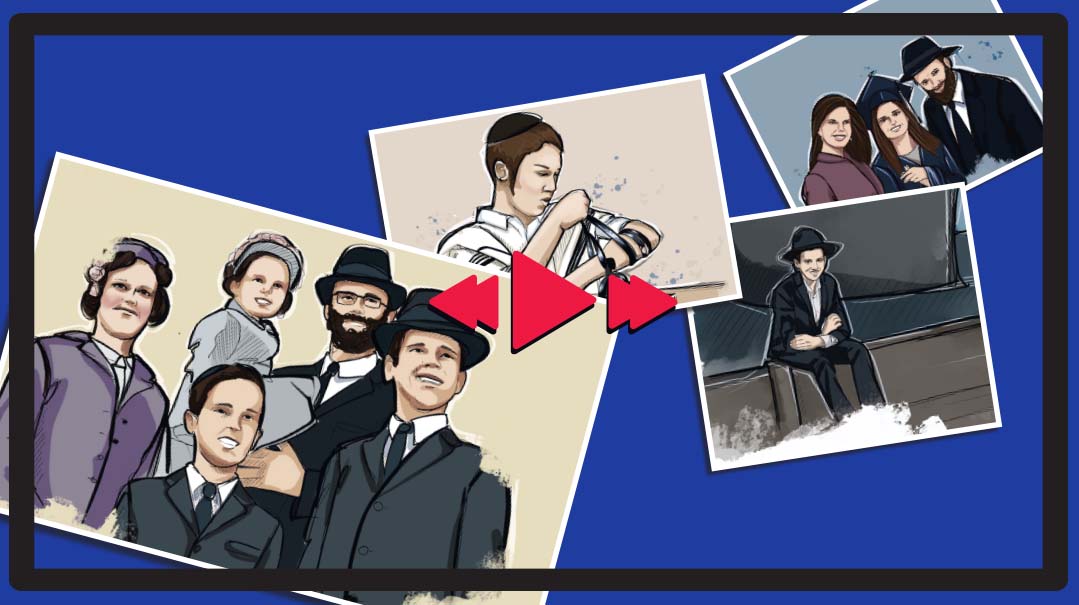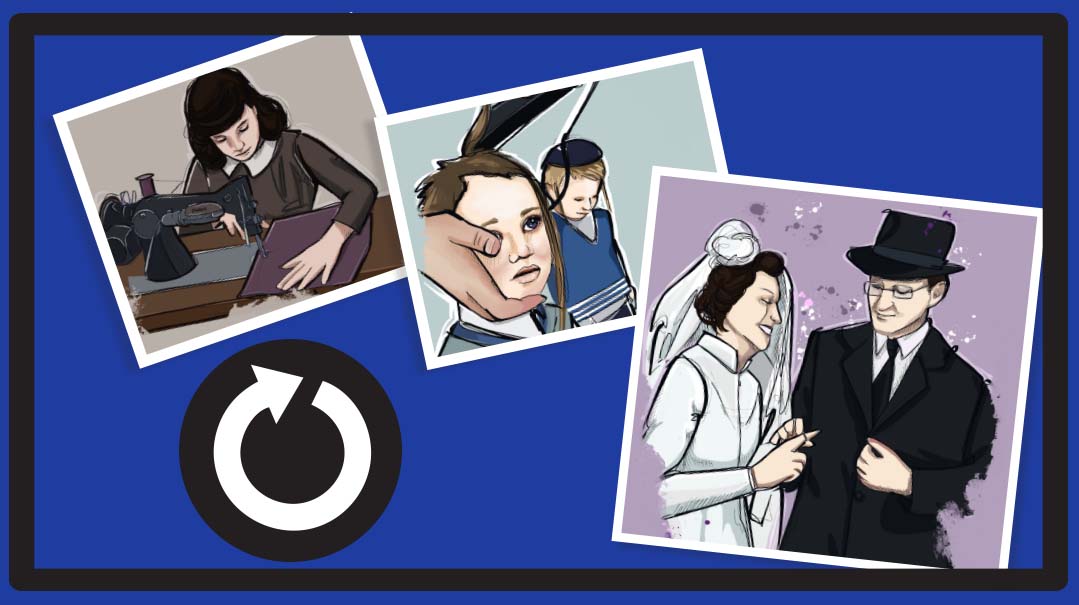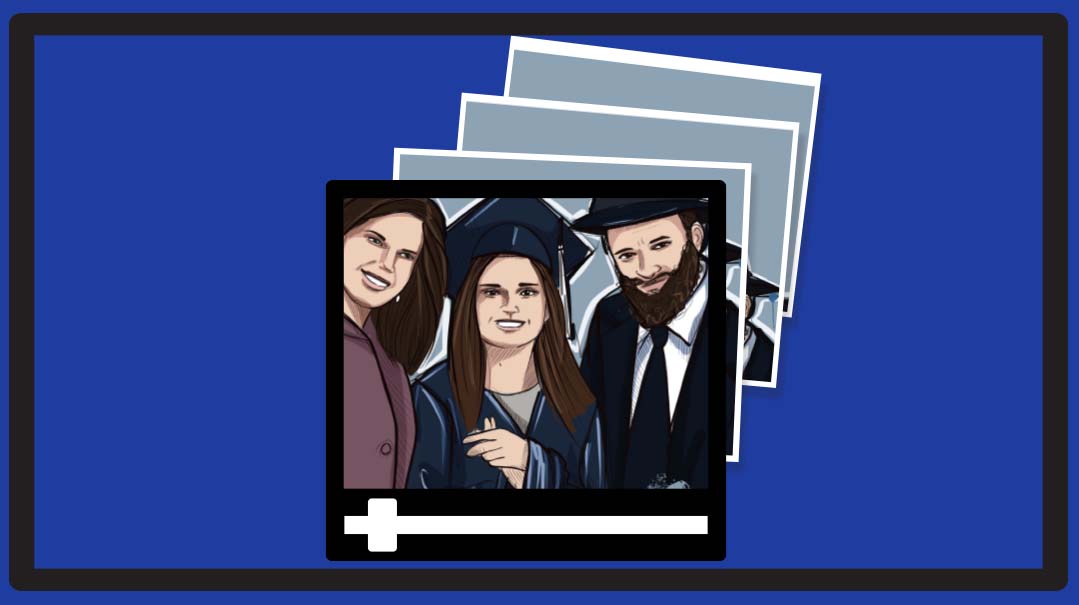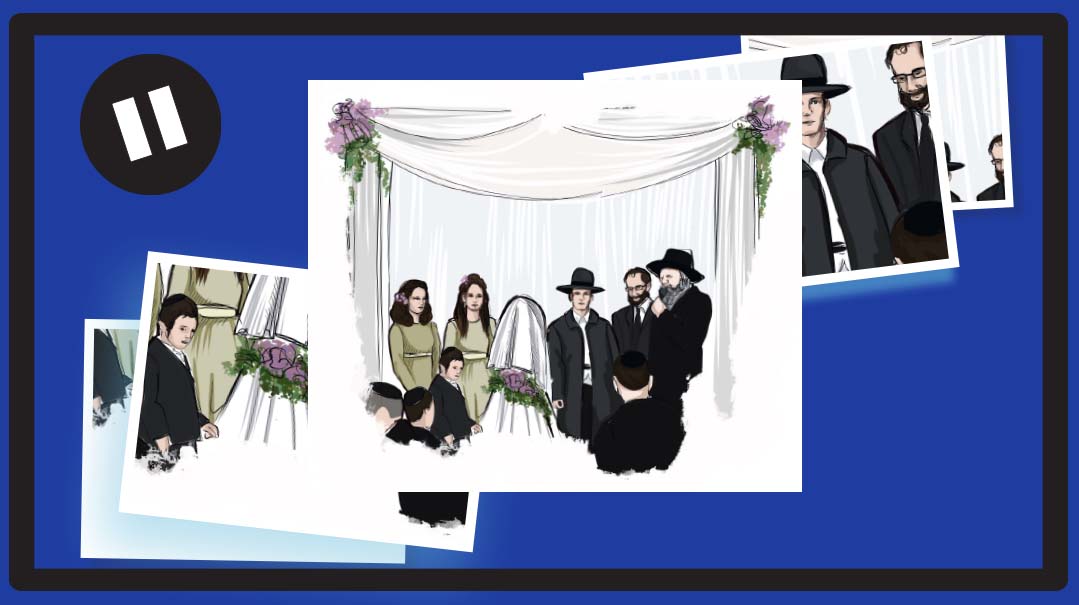Screen Time
| December 21, 2021The legacy of life stories, of challenges and victories, passed down by the elderly to inspire a new generation

Flipping through family photo albums is a great connector to the past, looking at old home movies or videos a nostalgic walk down memory lane.
Yet it can be jarring as well — looking at our lives from decades past can be a stark reminder of how fleeting it all is, and we begin to wonder:
Have we maximized, or have we wasted much of it away? For the elderly, wondering what they’ve left for their progeny or how much of their lives really mattered, the feelings can be especially acute.
For all their priceless value, photographs are still two-dimensional, and home movies only show a small section of time. But what if all that could be put together in a way that the past — in all of its richness and vigor — could be preserved in a compelling and relevant way for the next generation?
That’s why today, more and more people are opting to create legacy videos with their elderly family members as the stars. These projects capture not just memories or the simple outlines of family lore, but a rich legacy that can serve as a blueprint for generations to come. While a photograph freezes the past, a well-done legacy video has the ability to shape the future.
Today, the ubiquity and relative affordability of technology have made it easier to tell a richer story than ever before, capturing complex lives and bygone legacies. Whether created by the families themselves using common cell phones and editing software, or outsourced to professionals with more sophisticated equipment and training, the family legacy video is becoming one of the most popular and entertaining ways to preserve family history.

EVERYONE HAS A STORY
Because a legacy video is a short personal documentary that family and friends make in an effort to highlight a loved one’s stories and accomplishments. In addition to the value of creating it while our aging relatives are still alive, it’s especially valuable after they pass away. What better inheritance than a living library full of stories and information that loved-ones can connect to during their own difficult times, conveying timeless and priceless values that can truly enrich the family?
“Sometimes, when someone is struggling with a particular life challenge, they can invoke lessons learned from their own grandparents or great-grandparents and apply it to their particular situation,” says Miriam Buckwold, owner of Legacies, a company that documents family histories. “These videos create chains between generations, and of course, they generate even deeper love for those we thought we knew but about whom we can learn so much more. One client told me how she heard stories she never would have known about — it impacted her children to hear about her father’s accomplishments and how others emulated him.”
What about someone who lived a quiet, uneventful, and modest life, and didn’t experience what are considered dramatic challenges? Is there anything remarkable to be learned from their lives? According to Miriam, such people don’t exist.
“Everyone has a story,” she says, “no matter how supposedly humdrum and run-of-the mill their life may seem at first glance.” Skillful interviews can draw out and transform someone’s “no drama” life into what it really was, and is for everyone: a journey of challenges, of successes and failures, and of growth.
In addition, says Miriam, there’s nothing like seeing the expressions and hearing the voices of our loved ones in a way that brings them to life more than the written word or the still photograph.
“Watching a legacy video makes a family’s history come to life,” says Sheri Wagner-Kantor, CEO of Family Video Bios. “Suddenly the frail, elderly grandmother is transformed into a vibrant young woman. Perhaps her voice is superimposed in the background as a picture of her as a young adult flashes on the screen. Or maybe a simple video of her talking about those days brings that part of her alive again.” Sheri has heard from her clients how seeing and hearing about family history as told by grandparents themselves is stimulating and heartwarming in a way that the written word doesn’t always capture.

NEVER TOO LATE
The best time is now. Both Miriam and Sheri emphasize that it’s best to gather the stories and memories while the “star” is in a healthy and present state of mind: The clearer the mind, the clearer a picture the memories can paint.
“People find all kinds of excuses to push it off,” Miriam says. “The challenge is to just do it — because you really never know what can happen tomorrow.”
Yet even if one’s parent or grandparent has passed away, it’s still possible to create one, by gathering information, stories, and memories from talmidim, children, siblings, and friends, using any available voice recordings and pictures to fill in the gaps. Any significant documents or photos of family heirlooms can also be included in the video to bring the memories alive.
“We are so grateful that we captured the lives of our parents, a gift we gave them for their 60th anniversary, but really a gift we gave them to give to their grandchildren,” says one woman who, with Miriam’s help, got the project going “right under the wire. The Hashgachah was that we filmed it a few months before my mother became ill, and passed away shortly after. I’m so glad my parents were both still coherent at that time... it’s amazing to still hear their voices, see their mannerisms, and listen to their stories.”
Getting started
There are, of course, numerous benefits to hiring a professional who can produce a high-quality video with superior editing, music, and sound, but if a family wants to embark on this project on their own, here are some general rules to follow:
Appoint a point person (preferably a family member) to be in charge of the project. Begin the process by gathering photos and mementos, meaningful paraphernalia, and then start scheduling the interviews. You can also gather any voice recordings or family videos to intersperse throughout the legacy video. The more pictures and interviews, the better — even if you don’t think they have much value. If you do not have many pictures available to you, you can use images from other sources that depict locations and time periods that will be addressed throughout the video.
Sheri suggests asking family members for any specific questions or memories they would like addressed within the video. She relates how one family requested that she provide them with the unedited interviews so that they could then more easily identify points that they wanted explored more deeply. Sheri then followed up with a second interview to better focus on those areas.
Gaining input from family and friends can also be helpful. As Sheri points out, some family members and close friends are aware of stories and memories that others may have never heard before.
Do your research in advance. “If you ask detailed questions about a certain location or time period that display some of your own knowledge of the topic, there’s a much better chance that you’ll both jog their memory and that they’ll take you seriously enough to share it,” says Mishpacha’s Yisroel Besser, a seasoned interviewer who has written several biographies in which he heavily relied on family input. Sometimes the memories of elderly interviewees are sparked by questions about their hometown and photos from that time in their life.
Miriam adds that forming your list of general questions in advance and sending it to those who will be interviewed may allow for more forethought and better answers. She also suggests asking if there are any topics they would like not to discuss.
Make sure you have the right equipment. Lighting and sound quality are the most important technical aspects in the interview recording. Even if you plan to use a smartphone, you can purchase an inexpensive stand for stability, a microphone to clip on to the interviewee to enhance sound quality, and a light kit that will transform the visual experience. (And if the sound is not totally clear, you can add subtitles during the editing process.)

SETTING UP THE INTERVIEW
I never interviewed anyone before. What do I ask?
Schedule the interview for a day that you are flexible. You don’t want to be looking at your watch. Being relaxed will allow for a more organic experience, which will result in a higher quality interview. “Most importantly, make sure you give enough time for the interview,” says Besser. “When you come into an interview rushed, they’re stressed, you’re stressed, and they aren’t able to take the time to think of the details and memories that are most meaningful to them. Take the time to catch up before beginning — spend half an hour simply relating and cultivating connection.”
Sheri posits that the more patient you are, the more comfortable others will be in speaking with you. Sometimes, if a client is not comfortable speaking about a certain topic, merely establishing a rapport and patiently waiting will produce the details you hoped for.
Back when families lived together with multiple generations in one home, Miriam points out, there were so many natural organic conversations and story sharing that took place. With our fast paced and digital life, how often do we sit down with our loved ones and ask them questions?
Choose an interview location that lends itself to the topic, such as the family home. When interviewees are comfortable in their environments, they’ll speak more freely. You can also prompt the elderly with questions about pictures around their home, or other items that you see that might jog their memories or take them back to different times. Sheri tells of one man who was already in the throes of dementia, but every time he watched his interview afterward, he left with a sense of excitement and familiarity. Although the memories had slipped back into the recesses of his mind, each time he watched the video, he had a new sense of delight and surprise.
Create a video outline. Keep in mind that a lengthy video is less likely to be viewed in the future. Sheri suggests that the final cut should be about 25 minutes for one person, or 45 minutes for a couple. This means you now have a lot of editing to do, making sure to include key information from the earliest memories all the way through to the messages they wish to impart.
Conversely, Miriam suggests providing the family with both the cut and cleanly- edited version, and the longer version as well, so that they have the opportunity to hear it all if they ever desire. Once you have such treasures on tape, she says, why not share all of it with the family?
TIME FOR TALK, TIME FOR SILENCE
What are the best kinds of interview questions?
Once you’ve made sure you’ve covered the basics for the camera (name, location, place of birth, etc.), remember that the interview process is itself a gift to the elderly. Sheri recalls a time when one elderly woman was hesitant to be interviewed for a video her daughter wanted to compile. Yet, once she began talking, she didn’t want to stop. Later, the woman’s daughter told Sheri that her mother watches the video over and over again — that both the process of being interviewed and watching the interviews were deeply meaningful to her.
“They have so much to say,” Sheri relates, “and sometimes they just need to be coaxed to say it.” She also stresses the importance of showing parents and grandparents how much it means to us to hear their stories.
Ask the elderly details about their childhood home, their earliest memories, their younger siblings, what foods their mothers made, what tunes their fathers sang at the Shabbos table, what Yom Tov was like, what their parents’ role was in the community, and how they met their spouse. (Consider interviewing spouses separately.) Miriam suggests formatting the questions into chapters — for example, early life, life with children, etc. — so that viewers can more easily find the parts of the video they’d specifically like to watch.
Sheri says one of her clients shared with her that the interview process actually helped him to get to know his wife better than he ever did before. Listening to her answer questions in depth was surprising and exciting, he said.
On the interviewer’s side, though, sometimes the most important tool in gathering information is actually knowing when to stay quiet. “You want to create a comfortable and friendly ambience so that once the person starts talking. If you stay silent and give him the space he needs to think and consider, he will likely continue to talk,” says Yisroel Besser. “At the same time, use your face to nudge him forward. Look at him expectantly and with complete focus, which ultimately tells him, ‘Don’t stop, I want to hear more.’”
If a family is more secular and you’d like to bring out the Yiddishkeit from their roots, ask questions that pertain to their parents and grandparents and their customs, sacrifice, and dedication to their Judaism. This can also be inspiring for family members who want to navigate their own journey back to Yiddishkeit. Sheri remembers one baalas teshuvah who told her that watching the legacy video together with her non-religious siblings was a deeply bonding experience. During the interviews, Sheri made sure to bring up each of the grown children; it brought them much joy to hear about their parents’ love for each of them.
If your parent or grandparent mentions someone special, ask more about that person. If they mention their home or school, ask follow-up questions about that as well. Use their basic answers as clues to indicate the topics they may want to expound on.
Sheri recalls interviewing a survivor who was hesitant to talk about certain parts of her experience. But once she began talking, Sheri asked gentle questions, and before she knew it, she was talking about being taken in by a Jewish family, how she survived the war, and so much of what she had been through. The woman’s daughter shared with Sheri that her mother loved to watch the video over and over again — reexperiencing it all through hearing herself speak about it brought out a level of healing.

GETTING THE MESSAGE OUT
I want to draw out their challenges and victories. Am I getting too personal?
If someone is hesitant to share too much information about the bumps and challenges of her life, sometimes it helps to move sideways to parents and siblings, as that often sets the stage for the person’s background and ensuing life trials, helping to connect the current generation to the past.
This is a chance to ask questions that draw out stories of emunah and bitachon, says Miriam, and the interviewees should also be encouraged to discuss the core values they would like to transmit, what life lessons they’ve learned, and whether they have any advice they’d like to share with their children or grandchildren. It might start out slow, but at the end of the day, people give meaning to their challenges by sharing their victories.
“Ask if there’s anything you’d like your children or grandchildren to know about your experiences that could help in their own journeys,” Sheri suggests. She shares that one man wrote a poem — a message for his progeny — which she flashed on the screen as he read it in his own voice.
PUTTING IT TOGETHER
I’m ready to edit. How do I get that professional finish?
Choose appropriate music. After you’ve culled the interviews and tightened them up, think about the music that would fit the narrative. Sheri suggests choosing music from the time period being discussed. Miriam often uses music with lyrics that may somehow relate to the core messages. She shares one story of a survivor who use to sing the Hungarian song “Sol a Kakash Mar” to his grandchildren, and later, Miriam was able to find actual footage of him singing the song and she played it in the video. You can mix music softly into the background as pictures flash on the screen, or even as a backdrop to interviews that may directly relate to a specific song.
Gather photos, memorabilia, and old home movies. Look for items that you can splice in or overlay on top of what the interviewee is describing. Sometime items like heirloom jewelry or Judaica artifacts, letter collections, a wedding dress, or old children’s toys can add layers.
If they mention a certain village or time or area, you can look it up and add images that relate. One man, no longer religious, mentioned the shul in which he had his bar mitzvah, and Sheri was able to find an image of the shul online, which brought the memory to life for him. Sometimes providing a flash of a map on the screen can also give better context for the memories being discussed.
What if one of your relatives tells a great story but there are no photos or footage to supplement it? Perhaps some family members would want to become actors and recreate the event!
Choose the right editing software to use. One popular choice is iMovie, Apple’s video editor. This allows you to splice and edit video and sound, and insert photos and background music as needed. Of course, there is also an option of sending all the interviews and photos to a professional editor, saving the most difficult and tedious part for a professional.
Share your finished product. If the file is too large to text or email directly to your family, upload the video to a private link on YouTube or Vimeo instead and send it out to the mishpachah. You can also burn the video onto CDs and distribute.
Can you think of a better gift to share at your next family gathering or celebration than a legacy video, as family members watch their personal history play out before their eyes?
Besides preserving a personal or family history, there’s another fringe benefit to putting it all together: It’s an opportunity to consider our own way of living and consider the core messages that have shaped our lives. In addition to all of the gifts the legacy videos have to offer, they serve as a reminder that we are here for a greater purpose. If that would be us on the screen, what message would we impart to the next generation?
(Originally featured in Mishpacha, Issue 891)
Oops! We could not locate your form.






